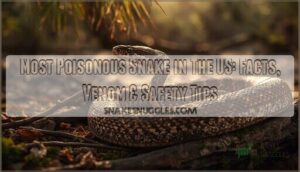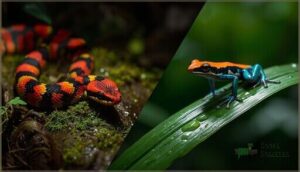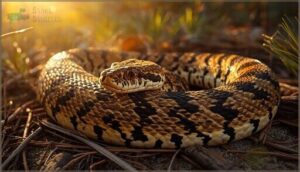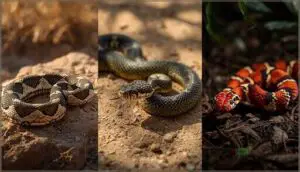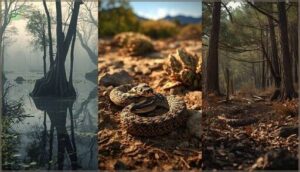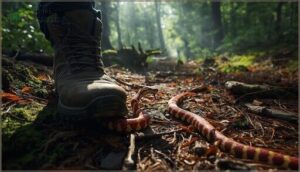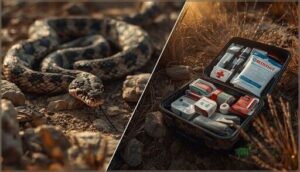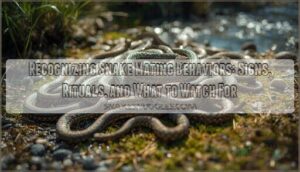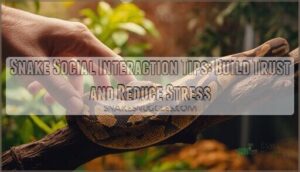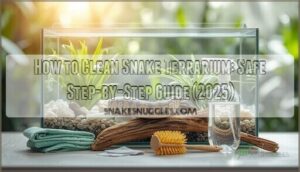This site is supported by our readers. We may earn a commission, at no cost to you, if you purchase through links.
Before you head into your backyard or plan that hiking trip through the Southeast, there’s something you should know: the most poisonous snake in the US—or more accurately, the most venomous—is likely closer than you think. The Eastern diamondback rattlesnake, Crotalus adamanteus, holds this ominous distinction, with venom yields that can exceed 400 milligrams in a single bite—enough to kill multiple adult humans without prompt treatment.
Yet the danger isn’t always where you’d expect. While the Eastern diamondback packs the largest venom volume, the Mojave rattlesnake’s neurotoxin-laced bite can prove equally lethal, and coral snakes deliver an entirely different threat that many people fatally underestimate.
Understanding which species pose the greatest risk in your region, how their venoms differ, and what actually happens during an encounter can mean the difference between a close call and a medical emergency.
Table Of Contents
- Key Takeaways
- Most Poisonous Snake in The US
- Venom Potency and Effects
- Geographic Range and Habitats
- Snake Behavior and Human Encounters
- Snakebite Prevention and Emergency Response
- Frequently Asked Questions (FAQs)
- How many venomous snakes are there in the United States?
- What is the largest venomous snake?
- Are there venomous snakes in North America?
- What are the deadliest snakes in America?
- Are venomous snakes dangerous?
- What is the most venomous snake in the ocean?
- What are the 4 venomous snakes in the US?
- What is the 1 deadliest snake in the world?
- Which is more poisonous, copperhead or cottonmouth?
- What is the most venomous snake in the United States?
- Conclusion
Key Takeaways
- The Eastern diamondback rattlesnake holds the distinction of most dangerous venomous snake in the US due to its massive venom yield of 400-450 mg per bite, though the Mojave rattlesnake’s venom is actually more potent with a lower LD50 of 0.18 mg/kg versus 1.2 mg/kg.
- Understanding the critical difference between venomous (injects toxins through fangs) and poisonous (harmful when eaten or touched) matters for proper risk assessment and medical response.
- Most snakebites occur in southern states during summer months and involve preventable human error—nearly 60% happen during intentional interaction attempts like capturing or killing the snake rather than accidental encounters.
- Immediate emergency response saves lives: call 911, immobilize the affected limb below heart level, and get to a hospital for antivenom treatment, which costs an average of $31,343 but reduces the already-low US fatality rate of just five deaths yearly.
Most Poisonous Snake in The US
When people talk about the most “poisonous” snake in the US, they’re usually confusing terminology—but that distinction matters more than you might think. The Eastern diamondback rattlesnake stands out as the most dangerous venomous species you’ll encounter on American soil, though several contenders deserve your attention.
Let’s clarify what makes a snake truly dangerous and which species pose the greatest threat.
Defining “Poisonous” Vs. “Venomous”
You’ll often hear the terms used interchangeably, but here’s the key distinction: venomous snakes actively inject toxins through specialized fangs, while poisonous animals harm you when eaten or touched. Think of it this way—if you bite it and suffer, it’s poison; if it bites you, that’s venom.
Venomous snakes inject toxins through fangs when they bite you, while poisonous animals harm you when you bite or touch them
Venom evolution equipped snakes with precise toxin delivery systems, making public health awareness essential for your safety. It’s important to understand that venoms are injected directly into the bloodstream.
Overview of The Eastern Diamondback Rattlesnake
When discussing the most venomous snakes in North America, you’ll find the Eastern Diamondback Rattlesnake (Crotalus adamanteus) stands out. This rattlesnake anatomy showcases impressive adaptations—adults reach 3 to 6 feet, occasionally 8 feet, with specimens weighing up to 34 pounds. Their venom research reveals yields averaging 400–450 mg per bite.
Habitat conservation efforts focus on longleaf pine savannas across southeastern states, where wildlife preservation remains critical for this declining species. The Eastern Diamondback’s population decline is largely due to habitat loss issues.
Comparison With Other Highly Venomous US Snakes
While the Eastern Diamondback Rattlesnake delivers substantial venom yields, the Mojave Rattlesnake (Crotalus scutulatus) possesses more potent venom—its LD50 of 0.18 mg/kg surpasses the Eastern Diamondback’s 1.2 mg/kg.
Coral Snakes (Micrurus species) exhibit different toxicity levels with neurotoxic effects, contrasting with hemotoxic rattlesnake species.
Snake evolution has shaped these bite patterns and venom resistance mechanisms differently across venomous snake species, creating distinct species interactions and medical significance.
Venom Potency and Effects
When you’re dealing with venomous snakes in the US, understanding what their venom actually does to your body can mean the difference between swift treatment and serious complications. Snake venoms aren’t all created equal—some destroy tissue and disrupt blood clotting, while others attack your nervous system and respiratory function.
Let’s break down the key differences in venom types and examine what makes the Eastern diamondback, Mojave rattlesnake, and coral snake so medically significant.
Hemotoxic Vs. Neurotoxic Venoms
Understanding the difference between hemotoxic venom and neurotoxic venom is essential when evaluating snake venom toxicity levels. Venomous snakes in the US deploy distinct venom classification strategies: hemotoxic venom disrupts blood coagulation and causes tissue hemorrhage, while neurotoxic venom blocks nerve transmission, leading to paralysis.
Envenomation symptoms vary dramatically, requiring specific antivenom efficacy protocols suited to each venom type for best treatment outcomes.
Eastern Diamondback Rattlesnake Venom
You’re dealing with one of nature’s most formidable biochemical weapons when you encounter Eastern Diamondback Rattlesnake venom. Its composition includes over 100 distinct toxins—primarily hemotoxic agents like zinc metalloproteinases and thrombin-like enzymes.
Toxicity levels are staggering: a single bite delivers 400-450 mg of venom, while just 100-150 mg proves lethal to humans. Snakebite symptoms include coagulopathy, tissue necrosis, and potential renal failure, though antivenom efficacy remains high with prompt treatment.
Remarkably, venom stability persists for decades.
Mojave Rattlesnake and Coral Snake Venom
Contrasting neurotoxic specialists reveals critical distinctions you’ll need to understand. Mojave Rattlesnake venom contains presynaptic neurotoxins with LD50 values as low as 0.23 mg/kg—more potent than Eastern Diamondback toxicity levels—causing respiratory paralysis. Coral Snake venom targets postsynaptic receptors, producing delayed snakebite symptoms:
- Venom composition differs: Mojave combines neurotoxins with hemorrhagic agents; Coral Snake delivers pure neurotoxic venom
- Neurotoxin effects include muscle weakness and breathing difficulty
- Antivenom efficacy requires species-specific treatment protocols
- Venomous snakes display varied clinical presentations
- Specialized antivenom administration remains essential for survival
Geographic Range and Habitats
Understanding where these venomous snakes live can help you stay safe when you’re hiking, camping, or working outdoors. Different species occupy distinct regions across the US, from coastal lowlands to arid deserts, and each has adapted to specific habitat types.
Let’s look at where you’re most likely to encounter the country’s deadliest serpents.
Eastern Diamondback Rattlesnake Distribution
You’ll find the Eastern Diamondback Rattlesnake across the Southeastern US, from southeastern North Carolina down through Florida’s coastal plain to the Keys, extending west to Louisiana.
Habitat loss has dramatically shrunk its geographic range—current populations represent only about 3% of historical numbers.
Conservation efforts now focus on protecting remaining longleaf pine savannas and reversing alarming population trends through prescribed burns and habitat connectivity.
Habitats of Other Dangerous US Snakes
While the Eastern Diamondback Rattlesnake dominates southeastern pine ecosystems, other venomous snakes occupy distinct ecological niches across the country. Coral Snakes are found beneath forest floors and wetland areas from North Carolina to Louisiana, often hidden under decaying logs. Copperheads thrive on rocky outcrops and mixed woodlands throughout the East.
In desert ecosystems, Mojave Rattlesnakes prefer sparse scrublands between 150–1500 meters elevation, utilizing rodent burrows for snake denning during inactive seasons.
Regional Snakebite Risks
Understanding regional snakebite risks requires examining geographic patterns and demographic factors that drive human-venomous snake encounters. Southern exposures create ideal conditions for rattlesnakes and copperheads, while rural risks increase during seasonal peaks when outdoor activity surges.
Key Regional Snakebite Risk Factors:
- Southern dominance – 82% of U.S. venomous snakebites occur in southern states where snake habitats and distribution overlap with human populations
- Texas leads nationally – 14.7 incidents per 100,000 residents, followed by Georgia (13.4) and West Virginia (11.3)
- Rural vulnerability – 34% of snakebites happen in less-populated counties despite smaller demographic representation
- Summer concentration – Over 50% of encounters occur during warmer months when both snakes and humans are most active outdoors
- Male predominance – Men account for 64-69% of victims, often through occupational or recreational wilderness exposure
Snake Behavior and Human Encounters
Most venomous snakes aren’t lurking around corners waiting to strike—they’d rather avoid you altogether. Understanding how these reptiles behave and what triggers defensive responses can mean the difference between a safe hike and a trip to the emergency room.
Let’s look at the warning signs, common bite scenarios, and risk factors you need to know before venturing into snake country.
Warning Signs and Defensive Behaviors
Venomous snakes deploy a complex array of defensive mechanisms before resorting to bites. Rattlesnakes, for example, employ rattle signals at frequencies up to 50 Hz, often warning potential threats from distances of 1.2–1.8 meters. Their defensive posture includes S-shaped coiling and head elevation, while camouflage tactics allow them to remain undetected in 40%–60% of encounters.
Strike behaviors and warning displays represent last-resort defensive behaviors when escape fails.
Common Situations Leading to Bites
You’re most likely to encounter venomous snakes during outdoor encounters in natural habitats, where nearly 60% of unintentional bites occur. Recreational risks peak during summer hiking and camping, especially in snake habitats across southern states.
Yard safety becomes critical too—about 34% of incidents happen near homes during landscaping or gardening.
Human error drives many cases: up to 60% involve intentional interaction, like attempting to capture or kill the snake.
Factors Increasing Bite Risk
Climate change amplifies snake bite risks—you’ll face a 6% higher chance for every degree Celsius rise in temperature. Weather patterns matter too: precipitation brings more snakes out, while droughts reduce encounters.
Your rural exposure increases threat levels, particularly during nighttime encounters when you can’t spot warning signs. Human activity in snake habitats during warm, humid periods creates the perfect storm for venomous snake encounters.
Snakebite Prevention and Emergency Response
You can’t unring the bell once a venomous snake strikes, but you can stack the odds in your favor before and after an encounter. Prevention starts with understanding where these reptiles live and how they behave, while knowing the right emergency response can mean the difference between a close call and a tragedy.
Here’s what you need to know about staying safe in snake country and responding correctly when things go sideways.
Protective Measures in Snake Habitats
You can dramatically reduce your snakebite risk through habitat modification—clearing debris, sealing holes, and trimming vegetation around your property. Landscape management, including rodent control, indirectly decreases snake presence in residential areas.
Personal protection matters: wear closed-toe boots and long pants when working outdoors.
Community education remains essential yet under-supported; fewer than half of surveyed individuals scored adequately on snake safety knowledge.
Immediate First Aid Steps
If a snake bites you, call 911 immediately. Keep calm and immobilize the affected limb below heart level—this slows venom circulation. Remove jewelry and tight clothing before swelling starts.
Clean the wound gently with soap and water, then cover it with a sterile dressing. Monitor symptoms closely: track swelling progression, breathing changes, and nausea.
Proper snakebite first aid and swift snake bite treatment save lives.
Antivenom and Medical Treatment Essentials
Within hours of a bite, you’ll receive CroFab or Anavip antivenom—both FDA-approved treatments covering all North American pit vipers. Doctors administer 4–6 vials initially, adjusting dosage based on symptom severity and coagulopathy development.
Emergency care includes continuous monitoring for adverse effects like allergic reactions, though these occur in under 5% of cases.
Treatment costs average $31,343, with antivenom representing the largest expense.
Frequently Asked Questions (FAQs)
How many venomous snakes are there in the United States?
Across the continental landscape, roughly 22 venomous snake species inhabit the United States, representing just 7% of our nation’s serpent diversity.
These dangerous snake bites originate primarily from rattlesnakes, copperheads, cottonmouths, and coral snakes.
What is the largest venomous snake?
The Eastern Diamondback Rattlesnake claims the title of largest venomous snake in the United States, with verified specimens reaching 7 feet 9 inches and weighing 34 pounds—unsurpassed among native rattlesnakes.
Are there venomous snakes in North America?
You’ll encounter a formidable array of venomous snakes across North America—over 20 distinct species including rattlesnakes, copperheads, cottonmouths, and coral snakes inhabit every state except Alaska and Hawaii.
What are the deadliest snakes in America?
Rattlesnakes account for over 90% of fatal venomous snakebites in America.
The Eastern diamondback poses the greatest mortality risk, while copperheads cause the most bites but rarely prove lethal compared to their rattlesnake cousins.
Are venomous snakes dangerous?
Picture a sudden strike, venom coursing through tissue—venomous snakes certainly pose serious risks.
Yet snakebite fatality rates remain remarkably low in the US, averaging just five deaths yearly among thousands of bites, thanks to effective antivenoms.
What is the most venomous snake in the ocean?
Dubois’ sea snake ranks as the most venomous snake in the ocean, with extraordinarily potent venom.
Found in Pacific Ocean waters around Australia, this species demonstrates sea snake toxicity exceeding most terrestrial counterparts.
What are the 4 venomous snakes in the US?
You’ll encounter four groups of venomous snakes across the country: rattlesnakes (32 species), copperheads, cottonmouths (water moccasins), and coral snakes.
Together, these pit vipers and elapids account for 98% of venomous bites nationwide.
What is the 1 deadliest snake in the world?
When discussing the deadliest snake globally, you’ll find the inland taipan possesses the most potent venom toxicity, but Russell’s viper causes more global snake deaths due to limited antivenom access and high human exposure.
Which is more poisonous, copperhead or cottonmouth?
Though people often use “poisonous” loosely, you need venom potency facts: cottonmouth venom surpasses copperhead in toxicity and yield.
Bite severity, envenomation effects, and treatment options differ greatly. Proper snake identification matters for medical response.
What is the most venomous snake in the United States?
The Mojave rattlesnake stands out for venom potency, featuring neurotoxic venom with the lowest LD50 among rattlesnakes.
However, the eastern diamondback rattlesnake causes more fatalities due to its exceptionally high venom yield.
Conclusion
You can walk past the most poisonous snake in the US a dozen times without incident—or provoke a single strike that demands immediate medical intervention. The difference lies in awareness, not luck.
Understanding venom mechanics, respecting territorial behaviors, and recognizing warning signs transform fear into preparedness. Whether you’re traversing Eastern diamondback territory or Mojave desert trails, your safety depends on knowledge applied deliberately.
Treat every encounter with caution, never with complacency, and you’ll navigate snake country confidently.
- https://health.clevelandclinic.org/poisonous-vs-venomous
- https://en.wikipedia.org/wiki/Venomous_snake
- https://lucec.loyno.edu/natural-history-writings/poisonous-and-venomous-snakes
- https://my.clevelandclinic.org/health/diseases/15647-snake-bites
- https://www.worldatlas.com/animals/the-9-most-venomous-snakes-in-the-united-states.html

